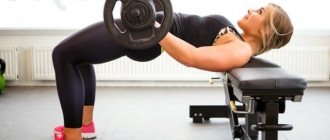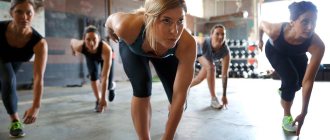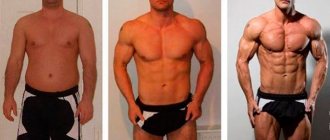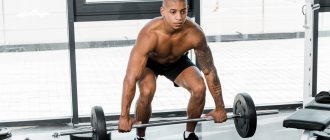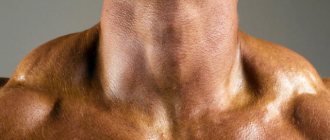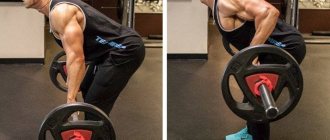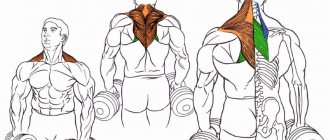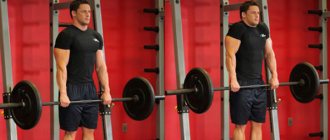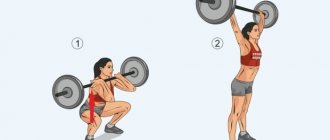What do we girls love to do most at the gym? That's right - pump up your buttocks. And each of us has our favorite “butt” exercises. For some it's barbell squats, for others it's lunges, but for me it's a glute bridge in a Smith machine. Why?
Pelvic lifts are isolated exercises where the entire load falls on a separate muscle group - in this case, the buttocks. But we know that this type of training is no longer used to increase muscle mass, but for an aesthetic effect. That is, when you need to “polish” existing volumes and bring them to an ideal shape. After all, you must admit that usually with isolated exercises we lift much less significant weight than with basic exercises.
But in the case of the gluteal bridge, a completely different picture appears here. As practice shows, any girl in this exercise is able to lift more weight (sometimes even two or three times more!) than with squats. Therefore, the “gluteal bridge” can to some extent be classified as conditionally basic.
The advantage is that pelvic lifts exclude the work of the quadriceps, which is very important for many. For example, like mine. The muscles of the front part of the thigh are already initially highly developed and instantly respond to any load. And the gluteal bridge, consider, completely eliminates their work and heavily loads the entire gluteal muscle group. Let's take a closer look at the muscle atlas.
What muscles work
As already mentioned, the exercise belongs to the class of conditionally basic and is aimed at developing the buttocks. A complete muscle atlas includes the following units:
- targeted – gluteus maximus muscle;
- synergists – quadriceps;
- stabilizers - hamstrings, back extensors, calf muscles, core muscles, rectus abdominis and obliques.
The exercise can be performed either with free weights (with a barbell) or in a Smith machine.
Basic mistakes
Despite the simplicity of performing the gluteal bridge, this exercise has its own characteristics that allow you to increase efficiency:
- To increase efficiency and do deeper work, carry out actions from a support. By leaning on a stand or bench, you will be able to lower your pelvis lower. Consequently, it will take more effort to lift it with your buttocks and, as a result, you will be able to achieve results in a shorter time;
- Breathing technique must be observed (lifting while inhaling, lowering while exhaling);
- When using additional weight, the load must be calculated correctly. The weight should be such that you can easily perform up to 10 repetitions with it for each of 2-3 approaches.
As for calculating weights, experienced trainers have developed more or less approximate indicators. They depend on the athlete’s level of training and his gender:
- girls are allowed to do 2-3 approaches with 10-20 repetitions in each and a weight of up to 500 g;
- guys can perform the same 2-3 sets of 10-20 repetitions with weights up to 10 kg.
Since these actions are not basic, they are best performed in conjunction with the main exercises of the training program. In this case, you will be provided with a more effective result.
- At the top point, the emphasis is not placed on the heel. This reduces the stress on the buttocks.
- Lack of fixation when raising the pelvis.
- The position of the legs is too close or far, which also does not allow the buttocks to work to the maximum.
- Abrupt relaxation at the bottom does not lead to progress.
- Switching to weights without preparation leads to injury.
In addition, during the exercise, especially for beginners, it is necessary to avoid mistakes:
- At the maximum point, emphasis should not be placed on the heel. This will reduce the load on the gluteal muscles.
- There is no fixation when raising the pelvis.
- Too close or too far a position of the lower extremities prevents the gluteal muscles from functioning fully.
- Sudden relaxation at the bottom will become an obstacle to progress.
- Weighting without preparation will lead to injury.
Execution technique
The exercise is performed naturally and is essentially a regular pelvic lift. The sequence of the exercise is as follows:
- Place the bar in the machine at the height of the bench and hang the required number of weights.
- Position the bench so that when performing the exercise, your shoulder blades are located on the bench, and the bar is at the level of the hip bones.
- Take a “bridge” position – shoulder blades on the bench, feet shoulder-width apart on the floor. The body and thighs are parallel to the floor, and the lower leg is perpendicular to it.
- Remove the bar from the supports and lower your pelvis down through the full range of motion.
- Inhale and as you exhale, lift your pelvis up, squeezing your buttocks at the end point. Do static tension for 1-2 counts.
- Repeat the movement the required number of times.
Note. Your feet can be placed not on the floor, but on a step platform with a certain number of lifts. This will significantly increase the range of motion. Accordingly, it is better to load the muscles of the buttocks.
Efficiency and benefits
Let's talk about the gluteal bridge - an exercise that develops the gluteal muscles and which can be performed by athletes of any level. Below we will look at the technique, muscles involved and the benefits of performing the mentioned movement.
The glute bridge works the gluteal muscles in isolation. Using additional weights isometrically loads the hamstrings and lower back.
Execution technique
- Lie on your back, bend your knees, place your hands on the floor along your torso. Make sure your feet are completely flat on the floor.
- Lift your pelvis off the ground and lift until it is in line with your shoulders and knees. At the end point, tightly tighten your gluteal muscles. Avoid hyperextension of your back.
- Stay in the upper position for a couple of seconds and return to the starting position under control.
There are a huge number of options for performing a gluteal bridge. The most common are dumbbell glute bridges; barbell; lying on a bench; one leg; with feet placed on a raised platform.
Below we will look at the benefits of doing a glute bridge. Although this is a fairly simple exercise, it will greatly help you increase your athleticism, explosiveness, and improve the look of that body part that everyone is so obsessed with.
Increased gluteal muscle strength. What you will need for deadlifts, lunges, and squats. The glute bridge is a great example of an assistance exercise for these movements. Perform it with additional weights for greater inclusion of the gluteal muscles.
The obvious advantages and real benefits of the exercise are expressed in the following facts:
- the buttocks are worked out without overloading the lower back, which cannot be said about squats;
- the ease of the exercise lies in the fact that in the basic version without weights, exercise equipment is not required, you can work at home;
- exercise promotes better blood circulation in the pelvic area, which means it improves the quality of sexual life;
- you can tighten your buttocks without doing squats;
- during the execution of the bridge, a colossal amount of calories is expended, thereby helping to control body weight;
- lifting the buttocks in different variations helps strengthen the abs;
- the exercise is performed with your own or any additional weight;
- The benefit of the pelvic lift also lies in increasing strength and developing muscles that are used in jumping and running.
We looked at how to do a glute bridge with a load and what its advantages are, but many have questions about the safety of the exercise. In general, the exercise can be called harmless. It can be contraindicated for a person only when he is not allowed physical activity as such.
Today, a huge number of people who start doing fitness suffer from varicose veins. With this disorder, you can perform pelvic lifts, since there is no axial load, and the body does not receive shocks as when jumping and running. The bridge does not create a lot of tension in the legs, the same cannot be said about squats with weights and other standing options.
The knee area is involved when performing pelvic lifts, but the joint is moderately loaded. Some athletes complain of knee pain from squats, but in the case of a bridge this is excluded, even if weights are used.
glute bridge on the floor without weight
Results can only be expected with regular training. The difference in achievements depends on the intensity of training, initial data and physiological characteristics. On average, the muscle worked increases by 50% within a few months.
There are a number of benefits that an athlete receives by adding a glute bridge to a program:
- the appearance of the buttocks changes: the percentage of fat decreases, elasticity and fit appear, and the shape improves;
- the load on the lumbar region is distributed correctly and evenly;
- an increase in strength indicators directly affects endurance: running, jumping and walking are easier;
- the lower back is strengthened, the muscles of the central part are stabilized, and back discomfort is no longer bothered;
- the development of the lumbar region reduces the risk of injury during sports activities, be it powerlifting, crossfit, weightlifting and track and field athletics, gymnastics, basketball and other sports. In addition to protecting against injury, strengthening the gluteal muscles helps improve performance in sports;
- exercise gives health to the pelvic organs and lumbar region.
Common execution mistakes
The glute bridge is an exercise in which it is difficult to make mistakes. But even here it is possible to make some errors.
- Incorrect foot placement . They should be shoulder-width apart and positioned so that the shin is perpendicular to the floor.
- Incorrect body position on the bench . Do not lean on your neck or lower back. Only on the shoulder blades.
- Incomplete range of motion . You need to lower and rise to full amplitude. Therefore, to place your feet, it is better to use not the floor, but a step platform with a sufficient number of lifts.
- Sudden movements when performing . Focus on static dynamics. Fast movements with jerks are not allowed.
Tips for maximum efficiency
- As always, I have to mention the importance of WARMING UP before your workout. Particular attention should be paid to the back and hip joint.
- As for the position of the legs. When bending them at the knee, an angle of 90° should form. If you place them close to the pelvis, then the load on the knee joint will increase.
- When lifting the pelvis up, all the weight should be on the heels. At the same time, there is no need to take your socks off the floor.
- You need to work exclusively with the gluteal muscles. In this case, movements must be controlled. When returning to the starting position, do not fall down.
- It is very important that the emphasis is on the shoulder area and not on the neck. This will put a lot of stress on the vertebrae and can cause neck injuries.
- When working with weights, you should choose the right weight. If you feel pain in the lower back, then your technique is incorrect. Try losing weight.
- The pelvis during movement should work in the same plane. Don't rock back and forth.
As you can see, the glute bridge is a great glute exercise. It can be performed by both girls and men. Some to give the gluteals an expressive shape, others to make these muscles stronger and improve results in basic exercises. Depending on this, the options and weight of the burden will be selected.
Good luck to everyone in your training!
Glute Bridge Options
We considered the option of performing the exercise in a Smith machine. There are other variations of execution. Let's find out how else you can perform pelvic lifts and consider why they are better or worse than the disassembled version.
Glute bridge with barbell . In terms of execution technique, this option is completely identical to the exercise described above, with the only difference being that you need to maintain balance. When performing exercises with free weights, stabilizer muscles will be activated. And in the Smith machine they are almost completely eliminated.
Glute bridge in the leg curl . The advantage is that the roller, unlike the barbell, is soft and does not put pressure on the hips. But the quality suffers noticeably. In my opinion, it’s very strong. I was never able to feel my buttocks working well.
Glute bridge with elastic band. An expander is a great way to diversify the load. In this case, we can perform both pelvic lifts up and down under the resistance of the elastic band, and spread our legs to the sides when the pelvis is raised. I would use both options exclusively for giving shape when there is already volume. For example, during a circuit training session on legs.
Gluteal bridge on a fitball. More often used by girls at home. With this exercise we can tone and tighten the buttocks, but we cannot influence their growth.
Glute bridge with support on one leg . This option is also suitable for home workouts when we exercise with our own weight. Or as a variety of workouts in the gym. Directly for butt growth, I recommend using a Smith machine or free weights.
Benefits of this exercise
- Giving the gluteal muscles an aesthetic appearance. They will become more fit.
- Also, the strength of the pelvic muscles will increase. Which will help improve results in more complex basic exercises.
- When performing a gluteal bridge, a small part of the load falls on the lower back. Therefore, the exercise is perfect for beginner athletes and people recovering from back injuries.
- The technique for performing a gluteal bridge is very simple. Athletes with any level of training can master it.
- By reducing blood stagnation in the pelvis, overall well-being improves. Thanks to this, the risk of health problems such as lower back pain, hemorrhoids, varicose veins and deterioration of reproductive function is reduced.
- The classic version does not require any equipment. Therefore, it can easily be performed at home.
- The muscles of the core and back are strengthened.
- During the glute bridge, the quadriceps are not included in the work. This news should especially please girls who do not want to have larger hips.
As you can see, the exercise has a long list of benefits. Which can not only enlarge the gluteal muscles, but also improve well-being. This bridge should not be performed by people experiencing pain in the lumbar and sacral region. First of all, you should consult a doctor and find out the cause of this disease.
Bridge from a standing position
If you don’t want to stop there, then the next step on the path to fully mastering the bridge exercise is to learn how to get into it from a standing position.
You can move on to mastering the bridge from a standing position only when you confidently perform the bridge from a lying position. If your bridge from a lying position is not completely stable or you are unable to fully straighten your arms and open your chest, then continue to perform lifting exercises and improve your body position in the bridge.
First stage: deflections to the wall
Stand with your back to the wall a short distance from it. Feet are shoulder-width apart, arms are lowered, heels are pressed firmly to the floor. The muscles of the abdomen, thighs and buttocks are tense. On your next inhalation, lean back and place your hands on the wall. Stay in this position for 15-30 seconds. Push off the wall and return to the starting position. Gradually, you can try to go lower, increasing the deflection in the spine.
Stage two: bridge against the wall
After enough practice of the previous exercise, where you can safely lean back with support, you can move on to the wall bridge. Stand with your back to the wall a short distance from it. As in the previous exercise, lean back and place your hands on the wall. Slowly walk along the wall down to the floor.
At first, you can only go down the wall, without returning up to the starting position if it is still difficult or uncomfortable for you. Constantly practicing wall bridges will allow you to perform this exercise more confidently every time. Gradually move away from the wall and use it only as a safety net.
Third stage: bridge with safety net
For this exercise, you will need a family member or buddy to assist you. Ask the belayer to support your lower back and hold your stomach with the other hand
In the process of mastering the standing bridge, it is very important to overcome the fear when you lean back into the bridge. It will be great if the belayer helps you both at the stage of bending into the bridge and at the stage of returning from the bridge to a standing position
Stage four: bridge with chair
This exercise will bring you even closer to confidently performing a bridge from a standing position. To perform this you will need a stable chair or sofa.
In this exercise, it is important to understand that the higher the chair, the easier it is to stand on the bridge. Therefore, you can start practicing the exercise from a higher sofa and end with a low bedside table or platform
Fifth stage: standing bridge
After completing all the previous exercises, you can move on to the bridge from a standing position. Perform the bridge slowly, controlling every movement. Try to look down between your hands to notice the floor in a timely manner. At first, it may be difficult for you to return from the bridge to a standing position, so we recommend that you use the help of a belayer or lean on the wall.
In order to feel more confident in the first stages of performing a bridge on your own, place pillows under your back. It will be psychologically easier for you to lower yourself into the bridge if you know that you have protected yourself from falling onto a hard floor.
There is no need to rush and force the load in the process of mastering the bridge. This is quite a difficult exercise for beginners, so be patient and be prepared to practice regularly if you want to do the bridge from a lying or standing position.
- How to learn to do pull-ups from scratch, exercises and tips
- How to choose sneakers for fitness: tips + best models
- How to choose dumbbells: tips, prices + selection of exercises
Crossfit complexes with exercise
Below are a few functional routines you can try in your next workout. The complexes are designed for experienced athletes; unprepared beginners are better off choosing something easier.
| Allbucks train | Complete 20 pull-ups, 20 push-ups, 20 dips, 20 jump squats, 20 Bulgarian lunges, 20 calf raises and a 100-meter sprint. Only 5 rounds. |
| Beautiful Mary | Complete 10 push-ups, 20 Bulgarian lunges with dumbbells, 30 sit-ups, and 40 air squats. Only 5 rounds. |
| Capture the Flag | Perform 30 barbell Bulgarian lunges, 20 barbell thrusters, and 10 box jumps. Only 3 rounds. |
Author Yaroslav Khvatov
Training experience - more than 8 years. Winner and medalist of All-Russian powerlifting and deadlift tournaments. Candidate for Master of Sports in deadlift.
With a barbell
This variation of the glute bridge can be performed in a Smith machine or simply with a barbell. If possible, use a soft pad on the bar or place a towel under it to reduce discomfort during movement. The correct technique for performing a bridge with a barbell or other weights for the gluteal muscles is as follows:
- Find a comfortable position in a Smith machine or power rack.
- Place the bar on your hips.
- Place your bent legs with your feet closer to your buttocks.
- Lift your hips off the floor along with the barbell.
- In the top position, the weight should be evenly distributed between the heels and the upper back, which you press into the floor.
- The abs should be tense and the back should remain straight.
Smith machine
The Smith glute bridge can be called a transition from the simplest exercise variants to perform to its most complex, but effective type - the bridge with a barbell.
When performing it, it is important to keep your buttocks tense and not sit on the floor, but only touch it with your buttocks
Technique for performing the Smith exercise: you need to install a bench next to the machine and lie on it with your shoulder blades, as when performing a variation of the gluteal bridge on a bench. You may need outside help to begin the exercise. You should start training in Smith with an empty bar. It should be located at the level of the hip bone.
Hold the bench with your hands, legs bent, shoulder-width apart, pelvis suspended. Start moving upward by tightening your buttocks. In this case, the hips form a straight line with the body. Hold at the top for a few seconds, squeezing your buttocks as much as possible. Get down, but don't sit on the floor! Do not hold your breath - as you exhale, your pelvis goes up, and as you inhale, it goes down. It will be a little hard at first, but after a few weeks you will be able to add weight to the bar.
As already mentioned, the next step to achieving a beautiful butt is a glute bridge performed with a barbell. We continue to consider the types of exercises presented.
Nutrition, daily routine and caloric intake of a natural athlete
You can gain weight without chemicals if you adhere to the rules of the training process and push through the natural limit of muscle growth with stress. But there are a number of other important aspects that a straight man must take into account when pumping without steroids.
1. Homemade food, products.
Without following a diet, the athlete will be defeated before the start of the fight. Muscles need to grow from something. Food is the nutritional base for muscle fibers. Easily digestible protein of animal and plant origin forms the basis of an athlete’s diet. Primary products:
» lean poultry (chicken breast, turkey); " fish; " cottage cheese; " egg white; » cereals, legumes and nuts (buckwheat, quinoa, lentils, almonds).
For a high-quality gain of muscle mass, it is important for the athlete not to exceed the daily calorie intake of meals. Excess calories, especially carbohydrates, can lead to an increase in subcutaneous fat, not just muscle
2. Sports nutrition, supplements.
A natural without anabolic steroids, but with high-quality nutrition and a disciplined training process, only needs protein and vitamin and mineral supplements. They act as an addition to the overall race for muscle growth. Protein powder mixture can be added to smoothies. Other sports nutrition does not promote progress in muscle building.
Training program for gaining muscle mass
3. Recovery, rest.
It is possible for a straight man to get pumped up without anabolic steroids, but not through daily training. Exhausting your body with exercise every day will not lead to anything good. But such work will ensure overwork. After a concentrated workout in the gym, the body needs a period of time to recover.
After hard work, muscles require rest for up to 48 hours. You can train every other day, but if the basic exercises were heavy and the working weight increased, it is better to take a break for two days. And after full recovery, return to classes.
Training programs
Both men and girls often include lunges with dumbbells in their complexes.
Most popular programs:
| Women's Leg Day. Emphasis on the back of the thigh and glutes | |
| Exercise | Sets x reps |
| Romanian barbell deadlift | 4x12 |
| Lunges with dumbbells with an emphasis on the hamstrings | 4x10 (for each leg) |
| Smith squats with emphasis on the hamstrings and glutes | 4x12 |
| Seated leg curls | 3x15 |
| Standing single leg curls | 3x15 |
| Glute bridge with barbell | 4x12 |
| Women's Leg Day | |
| Exercise | Sets x reps |
| Barbell Squats at Smith | 4x15 |
| Lunges with dumbbells | 4x10 (each leg) |
| Leg press in the simulator | 3x12 |
| Plie squats with dumbbells | 3x12 |
| Glute bridge with barbell | 4x12 |
| Superset of leg extensions and flexions in exercise machines | 3x12+12 |
| Men's Leg Day | |
| Exercise | Sets x reps |
| Squats | 4х12,10,8,6 |
| Romanian deadlift | 4x10 |
| Leg press in the simulator | 3x12 |
| Walking lunges with dumbbells | 3x10 (each leg) |
| Leg extensions in the simulator | 3x15 |
| Leg curls in a lying machine | 3x15 |
Contraindications
- Lunges with a barbell on the back are contraindicated and are not recommended for those athletes who cannot tolerate axial loads. We are talking about patients with intervertebral hernias and various protrusions;
- A weak muscle corset must be strengthened before the athlete performs the exercise with heavy weights;
- If an athlete has a problem back, it is better to perform lunges with dumbbells. The situation of a problematic back also includes hyperlordosis of the lumbar region;
- Otherwise, contraindications to lunges with a barbell are standard, these are injuries from which the athlete has not yet recovered, chronic diseases and viral diseases
Contraindications
It is generally accepted that this exercise is almost the safest for the knees, but this is not so. The load on the anterior cruciate ligaments is the same as in the case of a regular squat, so people with knee injuries should refrain from doing a barbell bridge too.
Naturally, a bridge cannot be made for diseases of the hip joints, as well as for gynecological diseases in women, since pressure is created on the pelvic organs. In such cases, you can replace the movement with an exercise without weight in static dynamics.
Glute bridges cannot replace other exercises for the legs and buttocks, and are used as the only basic exercise only if a person fundamentally does not want to pump up his quadriceps. In other cases, it is worth abandoning the one-sided approach and practicing more harmoniously.
Lying pelvic lift (bridge): technique and nuances
Watch this video on YouTube
Let's use the bench
The gluteal bridge on a bench can be performed in two versions.
First: the torso is in its original position on the floor, the legs are bent at an angle of 90 degrees and placed on a bench (chair, stand). Hands along the body or slightly to the sides. The pelvis rises as you exhale and falls as you inhale.
It is important to choose a comfortable bench height for yourself - your legs should not be lifted up too much
If the bench bridge seems too simple an exercise, you can complicate it a little and place your feet on an unstable surface. A fitball or basketball is good for this. The need to constantly balance so as not to lose balance. This will add stress to the muscles. If you have been practicing for several years, and this option does not scare you, try performing a gluteal bridge on an unstable surface on one leg.
Another option for a bridge on a bench. In this case, the shoulders and head are placed on a raised platform, the legs rest on the floor, and the feet are shoulder-width apart.
When performing the exercise, it is important to keep the buttocks squeezed and in constant tension, otherwise when they relax, an unnecessary deflection will form in the lower back, which can lead to injury. It is important to ensure that the head and neck are on a horizontal surface, otherwise the neck can be damaged
This version of the exercise can also be complicated, for example, by placing a dumbbell or a barbell plate on your hips.
Useful tips and tricks
As with any other exercise, there are nuances and features. By following them, you can not only get maximum efficiency, but also not injure yourself when working with heavy weights. Let's look at them in more detail:
Give yourself good stability. For these purposes, you can lie on the floor, having first laid a mat. But, for maximum convenience, it is better to simply use a wide bench that you can hold on to with your hands while doing the exercise. You can change the range of motion. For beginners, it is recommended to lower it to an angle of 90 degrees. But more experienced trainees can increase the range of motion, thereby working the target muscles even more. Do not lift your lower back off the bench. This can lead to injury, especially when lifting heavy weights. Ask your partner for help. Fixing the clamps on the bar yourself is not an easy task. This will require outside help. Learn to feel your muscles
The exercise will be effective only if you focus your attention on the working muscles, ensuring the correct technique. Choose the right weight correctly. You shouldn’t chase weights and break your technique at the same time.
It is better to do fewer repetitions, but as technically as possible. This will avoid injuries and unpleasant consequences. When including an exercise in a superset or complex, you should use it one of the first. The fact is that it is considered basic and loads many muscle groups. If your legs are tired, there is a chance that you will drop the bar on yourself.
How to include in training
According to Epperly, try to incorporate bridges into your workout once or twice a week, whether you're doing a full-body workout or just your legs. It’s especially cool to use this exercise after the main ones, for example, squats or deadlifts, as a finishing exercise.
If you're new to glute exercises, the classic bridge is enough to get your glutes on fire. But if you already have basic training and don't feel the burn after three or four sets, move on to one of these options:
- Add a fitness band, securing it to your legs just above the knees; As you lift your hips, extend your knees to maintain tension on the band.
- Pause at the top of the movement for 30 seconds.
- Place a dumbbell or barbell directly on your thighs. Hold them as you go up and down.
- Raise one leg parallel to the floor. Rise up and down, keeping your leg in this position. Switch legs every other set.
- Place your feet on a stable ball or bench/step before going up or down.
Or combine several of the above, the variations are endless.
